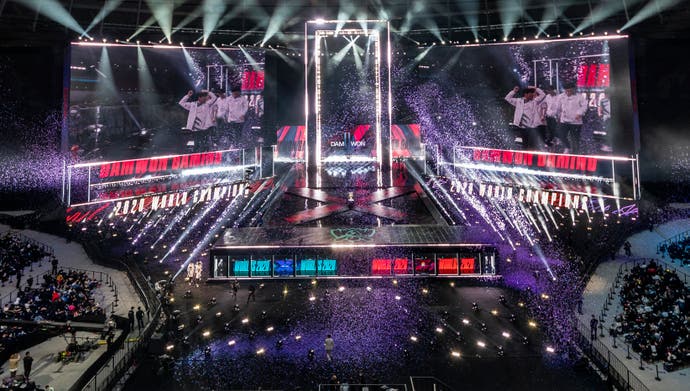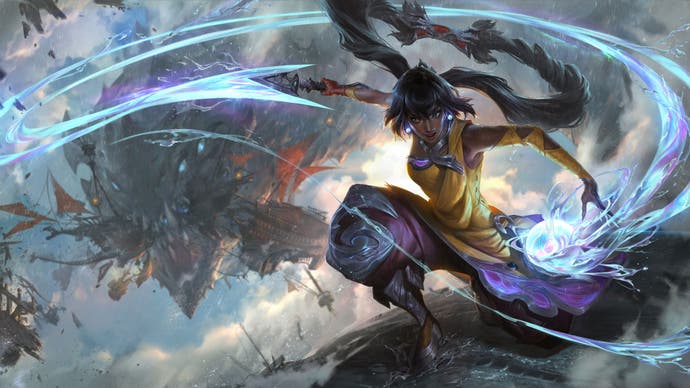State of the Game: League of Legends - a behemoth sustained by a determination to change
Zilean players and counting.
A year or two ago I'd taken a fairly lengthy break from League of Legends. There was a period, as so many MOBA players, or MMO players, or other game-that's-big-on-Twitch players will know too well, where I was all in. I knew the moves of every champion of the 140-odd that were out at the time, I knew the name and purpose and general viability of every item, I knew the optimal jungling route, the amount of seconds between respawning dragons, the situational builds for my mains and the match-ups with every one of their counters. Then came the welcome break, at which point you think you must be too far gone to ever come back. There's too much going on, too much that's changed, no room on this rocket for old-timers like you.
The secret to LoL of course is that this is, in fact, the game. The learning, and re-learning, and re-re-learning. You can play it without all that, under a veil of ignorance, and it will remain excellent: the cycle of earning gold and experience from killing enemies and popping minions like bubble-wrap, to use to buy more items and gain more levels, to more effectively kill enemies and on and on. This will never not be immensely satisfying and narcotically moreish, even with the LoL player's true addiction - to competition - put aside. But if you stick just to that you will be missing something, a little special sauce reserved for those who tip over into min-maxing obsession.
Let's step back a bit, though. The state of League of Legends, midway through 2022, is that it is utterly gigantic. You've probably heard that many times before - but it's also gigantic in a way that feels unusually stable. For one, this is because LoL has achieved what seems to be the ultimate goal for many video games: to expand into things that are not video games.
The obvious analogue is Blizzard's World of Warcraft - the similarities between LoL's Riot Games and Blizzard, and the unusual symmetry to the way those two mega-publishers are historically linked, is something we talked about at length with Riot co-founder and -chairman, Marc Merrill. Both have spread into other genres like card battlers and action-RPGs and team shooters, for instance. Both have, more importantly, been rocked by large-scale descrimination lawsuits (Riot agreed to pay a $100m settlement at the end of last year.)
This is where similarities begin to dry up, however, as one of League of Legends' great successes as Riot's poster child is its move into TV. Arcane, an animated LoL show that debuted on Netflix towards the end of 2021, was a huge success. A justified critical darling that is apparently plenty accessible to LoL newcomers but also packed with all the things fans love (namely some wink-to-the-camera easter eggs and oodles of precious lore), the show is also perfectly poised to expand, from the two-tiered city of Piltover and Zaun into the rest of Runeterra, League of Legends' host planet. The expectation is for many more seasons than just this one.
Shortly before Arcane released, Riot Games announced its monthly active players across all League of Legends-related games - League; its mobile and soon console-adapted version LoL: Wild Rift; the card battler Legends of Runeterra; and the auto battler Teamfight Tactics that's still launched from the League of Legends client - had reached an unprecedented 180 million, seemingly more than the entirety of Steam. Estimates put concurrent player peaks at somewhere between the eight to 12 million mark. Adding a hit Netflix series is unlikely to have caused a drop. Forget World of Warcraft - the new cultural and financial yardstick for League of Legends is probably Pokémon.

That's your context, and I appreciate there is a lot of it, but all of it matters. All of it, in a way, is an extension of League of Legends' marketing 'ecosystem' that does its best to envelop you as a player, to retain your attention and engagement. It's never been as vast or elaborate or downright luxuriously expensive as it is now.
Back to the game itself, as much as you can separate it from these things, and the actual moment-to-moment of League remains in largely good health. There will never be a time where League of Legends players are fully happy, partially because there's such a range of ability levels that change the way certain things might feel, but also because there are just too many players for them to all feel satisfied at once. The general consensus is that things have definitely been worse, but there will be individual periods, or even specific patches, where players of a certain role or position will point to things having been more to their taste.

The most recent major update beyond the fortnightly tune-ups was the Durability Update, which came at the end of May. The situation, as Riot made it, was that over the many years of League's live development there had been considerable 'damage creep' across all the different systems that impact how much damage players deal to one another - pre-match runes, in-match items, and limited-use summoner spells - but that all of these were, in Riot's words, "balanced relative to one another". The solution then was to increase the durability of all champions across the board.
It has, generally, been successful enough. The problem with LoL's damage creep was that if you play one of the low-health champions, like the glass cannon mages and ADCs (carries that do physical 'attack damage'), it was too easy to get killed in too few hits from an assassin champion. Generally, the theory goes, assassins of similar ability and in-game progress should be able to wipe out a squishy carry in one burst, but only if they 'all-in' them, using more or less every ability, spell and attack in their arsenal before having to show some skill to escape. The update - after a few predictably necessary tweaks - has generally brought things back to that level and provided everyone with Riot's holy grail: the all-important opportunity for counterplay (basically, the ability to survive an attack long enough to do something about it, if you have the skill).

It's tempting to big this change up a bit. Some described it as the biggest update in LoL history, which is technically true in terms of the number of champions affected, but nothing compared to, say, the reworked map that came in 2014, the addition of a team builder queue that let you lock into your preferred position before the game, the big item update in 2020 or even the remarkably successful work Riot's done behind the scenes to improve server reliability (shout out to fellow strugglers from EU West who were around in the early 2010s).
In actuality, this is exactly the type of change that happens on the regular with League of Legends - and again, this is exactly why I, and I think so many others, continue to play it. Over the many years spent on the Rift I've had to adapt to tank metas and mage metas and mobility metas, to the 'gates' meta, inspired by streamer Trick2G, where junglers would build their champions (usually Udyr) specifically to taunt, and subsequently run away from, the other nine players on the map and then go punch down enemy base turrets on their own - gates opened.
Each pre-season, where the game forces its players to take a couple of much-needed months off from ranked over the winter holidays, Riot will totally rework something significant. Every other month there's a new champion entirely to learn - we're now up to 161 at the time of writing - and there are thousands upon thousands of streamers or, beyond them, full-time professional players, who play the game for eight-plus hours a day in the search of new, miniscule ways to gain a dramatic edge. Throughout its life, and right now, League of Legends remains the same game it always has been: one where each match is entirely different to the last.
This piece is part of our State of the Game series, where we check in on some of the biggest service games running to see how they're getting on. You can find plenty more pieces like it in our State of the Game hub.










